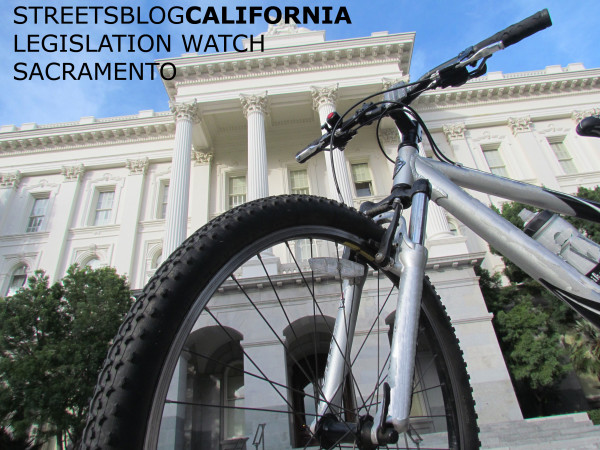Among the bills the state Senate and Assembly must decide upon before today's deadline—the session ends at midnight tonight—are several that attempt to make up for past and current injustices by giving voice to the California communities that are most affected by climate change and pollution.
This focus on environmental justice is finally gaining some traction in the state and in the legislature. People are beginning to openly discuss the legacies of redlining and restrictive covenants that have kept low-income people and people of color in certain areas, which then become the preferred locations of polluting industries and highway routes.
One of the bills, A.B. 1550 from Assemblymember Jimmy Gomez (D-Los Angeles), calls for 35 percent of all cap and trade funds to be invested in the communities that are most vulnerable to pollution and other effects from climate change. TransForm has issued a call to contact legislators to urge support of the bill, as its outcome is uncertain.
Another bill, S.B. 1000 from Senator Connie Leyva (D-Chino), would require cities and counties to address environmental justice in their General Plans in a meaningful way. It includes requirements to identify disadvantaged communities and to name policies and solutions for health risks in those communities. It also calls for naming policies that promote robust public engagement in planning decisions that affect those areas. It could be a game changer for neighborhoods that have historically, and are currently, the most vulnerable to negative effects from pollution, climate change, bad planning, and zoning.
A third bill, S.B. 1387 from Senate President Pro Tem Kevin de Leon (D-Los Angeles), calls for adding three members to the South Coast Air Quality Management District board who must reside and work with the communities within the South Coast Air Basin “that are disproportionately burdened by and vulnerable to high levels of pollution.”
The South Coast area suffers from some of the worst air quality in the nation, and the bill is partially in response to the controversial firing of the Air Quality Board's executive director and the board's new “business-friendly approach.”
Michele Hasson of the Center for Community Action and Environmental Justice (CCAEJ) said that when her group visited with South Coast legislators to urge them to support de Leon's bill, “they gave us, verbatim, the same talking points” that had shown up on documents sent out by the Western States Petroleum Association, the oil industry's lobbyist.
None of the current members of the board live in the communities most affected by bad air quality, she said. At this point, according to Hasson, the air quality plan “is completely based on giving incentives to industry. Basically, the SCAQMD is going to take tax money and give it to polluters, so the taxpaying members of the community are basically paying the polluters to buy a few electric cars.”
She despairs of the focus on politics at the expense of good policy. “People are dying,” she said. “This is a civil rights issue; they can't breathe.”
In addition to lobbying for de Leon's bill, the CCAEJ also sponsored Senator Leyva's bill calling for cities' General Plans to incorporate environmental justice issues. Based in Jurupa Valley, they have experience with what can happen when environmental justice issues are incorporated into the basic planning process. Jurupa Valley is one of only two cities in California that currently have an Environmental Justice element in their General Plan (the other one is National City).
Since the General Plan is considered the “constitution” of a city or county, setting out its vision for future growth and development, including environmental justice at that fundamental level can have a profound impact.
In Jurupa Valley, one particular community bore the brunt of local planning decisions in terms of its health and quality of life. “We saw 800 freight trucks an hour going through that area, driving past over 140 homes, right next to kids playing soccer,” said Hasson. “That community had elevated asthma rates, and the noise and exhaust were ludicrous.”
“When Jurupa valley did its EJ element, over 500 residents from EJ communities went to the meetings and actively participated in its development.”
“The great thing about S.B. 1000 is that it creates a positive vision for communities,” said Tiffany Eng, who works with the California Environmental Justice Alliance. “It can incorporate so many different aspects of a community, from housing to zoning to transportation modes, including active transportation. S.B. 1000 really gives disadvantaged communities, that are often communities of color, a voice and a process to have some of their environmental health and resource needs met.”
The benefits reach way beyond the particular communities in question, as well. For one thing, as local governments learn how to create and handle better public participation, everyone can take part. “When you're planning for the needs of disadvantaged communities, you're planning for the needs of everyone,” said Eng.
“You're also making smart investments. You don't want haphazard land use planning, which will lead to greater problems down the road. Efficient and thoughtful planing can prevent health problems as well as expenses to local governments in the future.”
Hasson has high praise for Senator Leyva, the bill's author. She worked hard to negotiated with groups that had originally opposed the bill, including the American Planning Association, the League of California Cities, and the California Building Industry Association, all of whom removed their opposition in the last day or so.
“She did it in a way that didn't compromise the integrity of the bill at all,” said Hasson. “Senator Leyva stands on principal, and does not play games. She wants to do the right thing, and she will take bullets to make it happen.”
“Our communities need this bill. It will improve the lives of millions of people,” she added. “If the bill is successful it will completely be a testament to the Senator's principled approach instead of a political approach,” she said.






